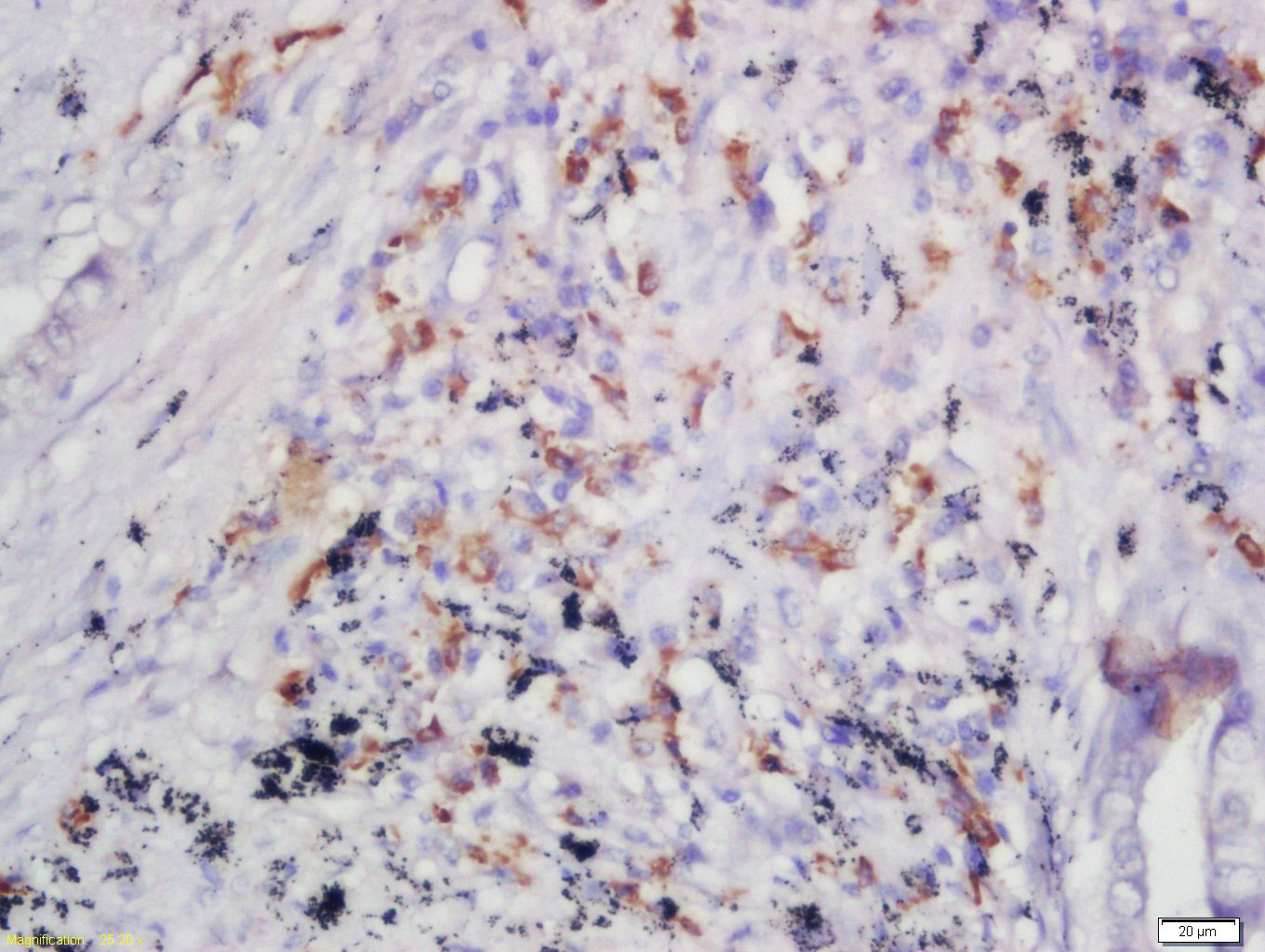
Rabbit Anti-Phospho-FLT3 (Tyr589 + Tyr591)antibody
CD135 antigen; Fetal liver kinase 2; FL cytokine receptor; Flk 2; Flk2; Flt 3; Flt3; FMS like tyrosine kinase 3; Fms related tyrosine kinase 3; Growth factor receptor tyrosine kinase type III; Stem cell tyrosine kinase 1; Stk 1; Stk1; Tyrosine protein kin
View History [Clear]
Details
Product Name Phospho-FLT3 (Tyr589 + Tyr591) Chinese Name 磷酸化FMS样酪氨酸激酶3 Alias CD135 antigen; Fetal liver kinase 2; FL cytokine receptor; Flk 2; Flk2; Flt 3; Flt3; FMS like tyrosine kinase 3; Fms related tyrosine kinase 3; Growth factor receptor tyrosine kinase type III; Stem cell tyrosine kinase 1; Stk 1; Stk1; Tyrosine protein kinase receptor FLT3; FLT3_HUMAN. Product Type Phosphorylated anti Research Area Kinases and Phosphatases Immunogen Species Rabbit Clonality Polyclonal React Species Human, (predicted: Mouse, ) Applications ELISA=1:5000-10000 IHC-P=1:100-500 IHC-F=1:100-500 IF=1:100-500 (Paraffin sections need antigen repair)
not yet tested in other applications.
optimal dilutions/concentrations should be determined by the end user.Theoretical molecular weight 109kDa Cellular localization cytoplasmic The cell membrane Form Liquid Concentration 1mg/ml immunogen KLH conjugated Synthesised phosphopeptide derived from human FLT3 around the phosphorylation site of Tyr589/591: NE(p-Y)F(p-Y)VD Lsotype IgG Purification affinity purified by Protein A Buffer Solution 0.01M TBS(pH7.4) with 1% BSA, 0.03% Proclin300 and 50% Glycerol. Storage Shipped at 4℃. Store at -20 °C for one year. Avoid repeated freeze/thaw cycles. Attention This product as supplied is intended for research use only, not for use in human, therapeutic or diagnostic applications. PubMed PubMed Product Detail CD135 is a tyrosine kinase receptor expressed on normal cells including CD34+ hematopoietic stem cells, myelomonocytic progenitors, primitive B cell progenitors, and thymocytes. CD135 is also expressed on malignant hematopoietic cells including AML, ALL and CML BC. CD135, also known as FMS-like tyrosine kinase 3, FLT3, STK1, and Flk2, is a growth factor receptor that binds the FLT3 ligand to promote the growth and differentiation of primitive hematopoietic cells. The intracytoplasmic domain of CD135 is modified by phosphorylation and has been shown to interact with Grb2, SOCS1, VAV1, and Shc. In humans, expression of Flt3 is restricted to subsets of CD34 positive as well as CD34 negative normal bone marrow cells. In these cells, the level of expression of Flt3 is rather low. Most of the CD34 bright Flt3+ cells co-express CD117 at high levels. They may represent early cycling, but not quiescent stem cells. Flt3+ cells in the CD34lo and CD34- populations do not co-express CD117 molecule and may represent B lymphoid precursors.
Function:
Tyrosine-protein kinase that acts as cell-surface receptor for the cytokine FLT3LG and regulates differentiation, proliferation and survival of hematopoietic progenitor cells and of dendritic cells. Promotes phosphorylation of SHC1 and AKT1, and activation of the downstream effector MTOR. Promotes activation of RAS signaling and phosphorylation of downstream kinases, including MAPK1/ERK2 and/or MAPK3/ERK1. Promotes phosphorylation of FES, FER, PTPN6/SHP, PTPN11/SHP-2, PLCG1, and STAT5A and/or STAT5B. Activation of wild-type FLT3 causes only marginal activation of STAT5A or STAT5B. Mutations that cause constitutive kinase activity promote cell proliferation and resistance to apoptosis via the activation of multiple signaling pathways.
Subunit:
Monomer in the absence of bound FLT3LG. Homodimer in the presence of bound FLT3LG. One homodimer interacts with one FLT3LG molecule. Interacts with FIZ1 following ligand activation (By similarity). Interacts with FES, FER and GRB2. Interacts with PTPRJ/DEP-1 and PTPN11/SHP2.
Subcellular Location:
Membrane; Single-pass type I membrane protein. Endoplasmic reticulum lumen.
Tissue Specificity:
Detected in bone marrow, in hematopoietic stem cells, in myeloid progenitor cells and in granulocyte/macrophage progenitor cells (at protein level). Detected in bone marrow, liver, thymus, spleen and lymph node, and at low levels in kidney and pancreas. Highly expressed in T-cell leukemia.
Post-translational modifications:
N-glycosylated, contains complex N-glycans with sialic acid.
Autophosphorylated on several tyrosine residues in response to FLT3LG binding. FLT3LG binding also increases phosphorylation of mutant kinases that are constitutively activated. Dephosphorylated by PTPRJ/DEP-1, PTPN1, PTPN6/SHP-1, and to a lesser degree by PTPN12. Dephosphorylation is important for export from the endoplasmic reticulum and location at the cell membrane.
DISEASE:
Defects in FLT3 are a cause of acute myelogenous leukemia (AML) [MIM:601626]. AML is a malignant disease in which hematopoietic precursors are arrested in an early stage of development. Note=Somatic mutations that lead to constitutive activation of FLT3 are frequent in AML patients. These mutations fall into two classes, the most common being in-frame internal tandem duplications of variable length in the juxtamembrane region that disrupt the normal regulation of the kinase activity. Likewise, point mutations in the activation loop of the kinase domain can result in a constitutively activated kinase.
Similarity:
Belongs to the protein kinase superfamily. Tyr protein kinase family. CSF-1/PDGF receptor subfamily.
Contains 1 Ig-like C2-type (immunoglobulin-like) domain.
Contains 1 protein kinase domain.
SWISS:
P36888
Gene ID:
2322
Database links:Entrez Gene: 2322 Human
Entrez Gene: 14255 Mouse
Omim: 136351 Human
SwissProt: P36888 Human
SwissProt: Q00342 Mouse
Unigene: 507590 Human
Unigene: 194 Mouse
Unigene: 6774 Rat
Product Picture
Antigen retrieval: citrate buffer ( 0.01M, pH 6.0 ), Boiling bathing for 15min; Block endogenous peroxidase by 3% Hydrogen peroxide for 30min; Blocking buffer (normal goat serum,C-0005) at 37℃ for 20 min;
Incubation: Anti-Phospho-FLT3 (Tyr589 + Tyr591) Polyclonal Antibody, Unconjugated(SL3149R) 1:200, overnight at 4°C, followed by conjugation to the secondary antibody(SP-0023) and DAB(C-0010) staining
Bought notes(bought amounts latest0)
No one bought this product
User Comment(Total0User Comment Num)
- No comment



 +86 571 56623320
+86 571 56623320
 +86 18668110335
+86 18668110335

